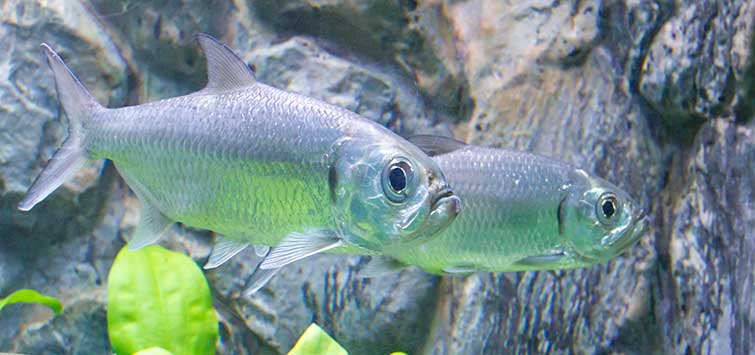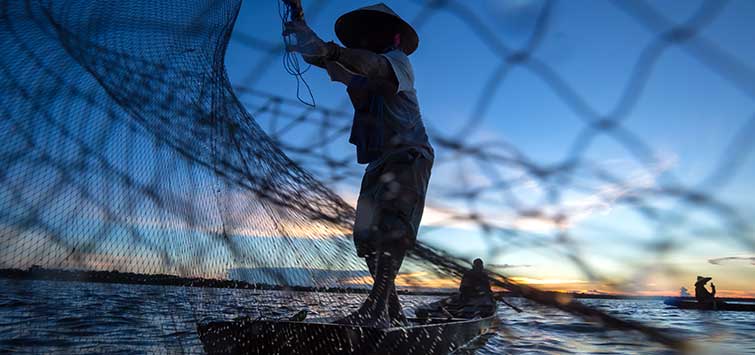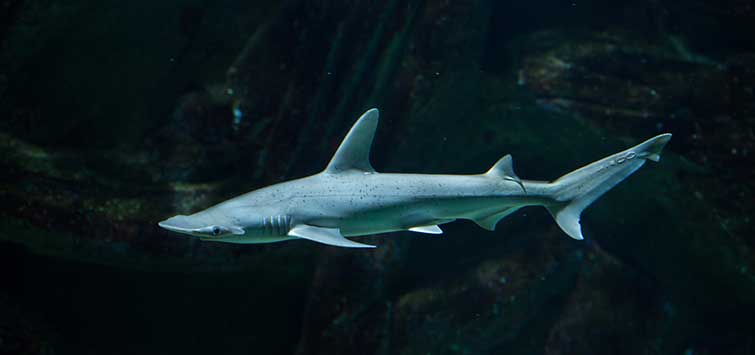Top of the Food Chain: The Indo-Pacific Tarpon Megalops cyprinoides
Author: Brian M. Scott
The purpose of this month’s “Top of the Food Chain” is to introduce a fish that’s fairly new on the predatory fishkeeping scene. Even though Megalops have been sporadically imported into the United States for many years, only recently has the serious interest in the successful long-term keeping of this group been explored.
Also, until fairly recently, hobbyists were under the assumption that there were many species of Megalops, which may have been due to the varying sizes imported or the slight color differences of specimens collected from different locales. In fact, there are only two true tarpons: M. cyprinoides (Pacific) and M. atlanticus (Atlantic). The others have been moved from Megalops into various other genera and are now considered herrings or shads, not tarpons as they were previously considered. Today, nearly all imported specimens are from aquaculture sources.
Synonymy
Because there is so little information on M. cyprinoides regarding their care in aquaria, interested hobbyists will definitely need to search for snippets of useful information on the fish. To assist you in your research, here are some of synonyms that various authors have assigned to M. cyprinoides over the last couple of centuries: M. cundinga, M. curtifilis, M. filamentosus, M. indicus, M. macrophthalmus, M. macropterus, M. oligolepis, and M. setipinnis.
Distribution and Habitat
The Indo-Pacific tarpon is a widely distributed species that inhabits both fresh and marine environments throughout its range. More often, they are found in estuaries or close to river mouths where they frequently travel in and out of fresh water depending on the tides (amphidromous). Specimens have been confirmed as far inland as Lake Malawi, Tanzania, Africa.
Adults are usually seafaring, while young-of-year and sub-adults often migrate from the open-ocean spawning grounds to the nutrient-rich habitats provided by bays and estuaries. Many small specimens travel up river mouths and may spend their lives in freshwater bodies of water, although it is more common to find adults in the open ocean. Lake-locked tarpon are not uncommon, however, and the biology of the species allows it to thrive in such environments for many years, thus allowing full growth potential.
Submerged Cover
Only small specimens are commonly seen hiding among root tangles and other forms of submerged cover. Sub-adults and adults are benthopelagic, open-ocean swimmers that have a maximum depth recording of some 50 meters. They are commonly found in association with wrecks or other submerged structure, which they hover over, but not within like the juveniles.
Tank Considerations
Any Indo-Pacific tarpon (or even Atlantic tarpon, for that matter) should be housed in an aquarium containing little to no structure, as their flighty behavior sometimes sends them crashing into the tank’s decor, thus encouraging the chance of wounds and the development of secondary infections.
Diet and Feeding
Tarpon, as a whole, are predaceous on a wide variety of foods. M. cyprinoides differs from M. atlanticus in that smaller foodstuffs are preferred over larger ones. This is surely related to the eventual sizes that both species attain, and at 5 feet (150 cm) M. cyprinoides simply cannot swallow the same size foods as, say, an 8-foot (250-cm) M. atlanticus. Regardless, even when two specimens of the same size are compared, M. cyprinoides will prefer smaller foods, while M. atlanticus is apt to take both small and large edibles.
Small Shrimp and Fishes
The best foods for captive M. cyprinoides are small shrimps and fishes, with fishes being easier to digest. Feeding should be done every-other day, so as to not allow excessive metabolites to develop in their aquarium water. There is little information regarding a sound feeding practice, but when we look at herrings and shads—both close relatives of the tarpon—we see an active feeding schedule, which may signify a high metabolic rate. Thus, a constant flow of nutrients through the active feeding on small foodstuffs is probably best. In aquariums where the swimming room is limited, the metabolic rate may be slowed, and so a feeding regimen of every-other day is probably best. A lot of further research is desperately needed in this area.
Prepared Foods
Since many, if not all, of the Indo-Pacific tarpon available to hobbyists are from cultured stock, they should readily accept prepared feeds. Due to cost restraints, most feeds used in aquaculture take the form of pellets. Some, however, are granular or crumble-like in form. Granules or crumbles are mostly used for juveniles or post-larval-stage specimens. The inclusion of a prepared food in their diet, either as a staple or a supplement, is strongly suggested.
Water Quality Concerns
There seems to be some concern among keepers regarding the water quality parameters for tarpons. It is always best to keep the water quality as high as possible, as very few fishes actually thrive in poor water quality. Just what is high quality, then? Assuming that the Indo-Pacific tarpon is a cultured fish, they are most certainly accustomed to a pH range of 6.5 to 7.5. Keeping your pH around neutral (7.0) will be fine. Be aware that pH is often over-emphasized, as it really does not mean a whole lot unless you are using it to balance more complicated water chemistries (i.e., hardness, buffering capacity, etc.).
Nitrate
Nitrogen compounds like ammonia, nitrite, and nitrate should always be kept to a minimum. Nitrate will be difficult to keep low with conventional filtration, so many keepers test for this compound every few days. The actual measurement will vary depending on test kits. In other words, some kits test in parts per million (ppm) while others measure in milliequivalents per liter (meq/l). Pay close attention to the instructions for the test kit. When nitrates accumulate to unsafe levels, simply perform a large water change to bring the nitrate concentrations back to safe levels. The amount of water that needs to be changed to do this will vary due to tank size, number of fish in the tank, filtration device(s) used, and amount and type of food utilized. Be sure to consult your local aquatic pet expert regarding the fine tuning of your water change regimen.
Reducing Nitrate
Understanding that the best method of maintaining high quality water is through large-scale, frequent water changes, which will effectively reduce high levels of nitrate, is important, and a strict regimen of such water changes is needed to maintain high water quality. However, some hobbyists prefer less drastic measures. There are various forms of filtration—albeit often very expensive—that will assist in the reduction of nitrates and other nitrogenous compounds. Additionally, the use of live plants will certainly reduce high levels of nitrate, as well as phosphate, which is another compound that is less toxic to fish but can be seen in the form of the green and brown algae that forms on your aquarium’s glass and decor.
Don’t use Live Plants
Live plants, while effective and attractive, are not commonly employed in large setups containing predatory species like tarpons. They often get uprooted or eaten by the inhabitants. Worse yet, some large fish just seem to enjoy picking them apart, which causes plant pieces to clog your filter intake(s) and cause a host of other issues that basically move your water quality in a negative direction. Some large fishes do not bother live plants (or even fake ones for that matter), and while tarpon are one of these (usually), it is still not recommended to house them together with plants.
Another factor that may cause negative results with live plants is the use of aquarium salt with tarpon setups. The Indo-Pacific tarpon can live its whole life in fresh water. However, some prefer to include them in an estuary setup, which may include other fishes such as scats, archerfishes, some cichlids, gars, Datnioides, and other types that have the ability to live in brackish conditions. Of course, you may want to concern yourself more with housing tarpons with fishes they ultimately cannot eat, which will be a much more daunting task.
Tankmates
There are many fishes that will successfully cohabitate in a setup containing tarpons. However, there are fewer fishes that will cohabitate with tarpons when they reach a meter in length! What starts off as a beautiful and successful setup may turn into a species-specific display as the tarpons systematically consume each of their tankmates and grow as time goes by. This issue of tankmate consumption is a far greater issue than aggression. Of course, tarpons can defend themselves very effectively with their large mouths and powerful tails.
Tarpons should never be crowded. They need swimming room, which is why it is not recommended to house them in heavily decorated aquariums. And they should not be housed in tanks that are overcrowded with fishes either.
Tarpons seem to stress easily, and when stressed, a common reaction is to launch themselves away from the stressor(s). In this case, it usually ends up with a messy ejection right out of their aquarium. Often, if more than one tarpon is housed together, one that jumps will trigger another to jump, and all of a sudden you have several large, flashy fish knocking the hoods off your tank. At first this may sound cool…but it’s not.
A Matter of Size
Although we typically deal with very large fishes in this column, this month’s subject is a truly gargantuan species. Although they are commonly available as specimens only a few inches long, the adult size for the Pacific tarpon is about 5 feet, and for its Atlantic congener, about 8 feet! This easily places these fish in the category of fishes suitable only for the hugest custom-made aquaria—in the tens of thousands of gallons.
Conclusion
The Indo-Pacific tarpon is a large-growing, widely distributed fish native to both fresh and marine habitats. It requires an immense tank. While most specimens are from cultured sources, many hobbyists still keep them in large biotope-type aquariums. The use of salt in such systems in not necessary, but some prefer to add it anyway. They do well on a diet of small fishes and shrimps, and they should be provided a form of pellet feed in their diet as well.

.png?h=595&iar=0&w=2781&hash=5FD5E69473BCC22199FBFA2FB71B6033)



